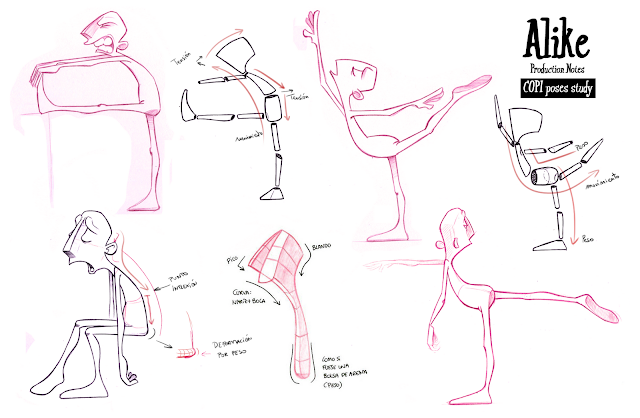Glen keane Reference Poses here
Our director of Animation Rafael Cano"Rafiki" gave the team some lessons on how "Copi" should be drawn.
But wait a second! Did he use the word drawn? Wasn't this supposed to be a 3D short? Well.. yes, you are right, but the origin of Animation has always been 2D.
A common flaw found in 3D is that you only pose a marionette, but you are not actually drawing the pose. A 2D Animator has no other choice but to draw his character facing a blank sheet of paper every time he needs a new pose.
We could say then, that in 2D you have to model and animate at the same time, always trying to find lines of action that will express best what we want to transmit. A 2D Animator can not rotate the character or move the camera trying what works best. And even though that is an advantage 3D offers, often it can lead to a lack of thought from the 3D Animator's part, resulting in a posed marionette and not a "drawn" pose.
Thankfully we have AniSculpt in Blender. That is what we call the process of being able to sculpt in real time on the character's shape, to be able to "draw" the pose better. Which is why Rafiki's drawing session was held in the first place, to be able to understand how Copy is build and how to best draw poses for him.
Daniel
Nuestro director de animación Rafael Cano "Rafiki" hizo una sesión de cómo dibujar a "Copi".
Nuestro director de animación Rafael Cano "Rafiki" hizo una sesión de cómo dibujar a "Copi".
Pero... ¡un momento!, ¿dibujar? ¿pero esto no era un corto en 3D? Sí, pero la "madre" de todo es el 2D.
Un error común que tiene el 3D es que solo posas una marioneta, no dibujas la pose. Un animador 2D se ve obligado a dibujar todo el personaje partiendo de un folio en blanco. Podríamos decir que un animador 2D tiene que modelar y animar a la vez y, ya que lo tiene que dibujar entero, un buen animador pondrá cada linea en su sitio buscando con ello la pose que mejor exprese lo que quiere transmitir. Un animador 2D cuando tiene la pose dibujada no puede ni rotar el modelo o mover la cámara buscando que funcione mejor como se puede hacer en 3D, aunque esto es una "ventaja"del 3D, a menudo se convierte en una falta de reflexión previa por parte del animador 3D al posar un personaje, posas la marioneta sin pensar en "dibujar" la pose.
Afortunadamente en Blender tenemos el AniSculpt, así es como llamamos nosotros a la posibilidad de esculpir de forma animada la estructura del personaje para poder "dibujar" la pose, asi que esta sesión de 2D con Rafiki sirve para entender como esta construido Copi y "dibujar" mejor las poses.
Daniel


No comments:
Post a Comment